Once again Bell Shakespeare’s King Lear isn’t quite right
By Cameron Woodhead, Andrew Fuhrmann and Jessica Nicholas
THEATRE
King Lear ★★★
Bell Shakespeare, Arts Centre Melbourne, until August 11
Bell Shakespeare has a spotted history with King Lear. Veteran theatregoers won’t have forgotten the disaster of Barrie Kosky directing John Bell in 1998. The attempt to reimagine the tragedy as apocalyptic carnival was doomed to be a vaudevillian misfire, Kosky’s avant-garde vision clashing badly with Bell’s rather classical approach to Shakespearean acting.
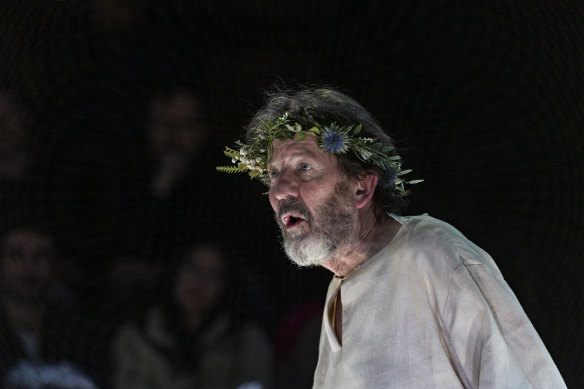
Robert Menzies as King Lear.Credit: Brett Boardman
Drawing inspiration from the austerity of Japanese performance traditions, Marion Potts overcompensated for Kosky’s misadventure in her elegant but dull 2010 effort, again with John Bell.
And the latest production, starring Robert Menzies as Lear, should be better than it is. Menzies is a very fine actor, and the air of haunted dishevelment about him is certainly no disqualification for the role.
In fact, looking like a Beckett character may be an advantage: King Lear is the closest Shakespeare comes to envisaging human extinction and, as critic Jan Kott noted, it prefigures absurdist drama.
Unfortunately, director Peter Evans short-changes the talent in his charge. Menzies’ Lear is a shadow of what it might yet become in firmer and more sophisticated hands. (The actor hasn’t hit 70, after all, and Lear claims to be a Biden-like “fourscore and upward”.)
This Lear feels like a rehearsal for something more fully imagined and embodied. None can fault Menzies’ command of Shakespeare’s language. The cruelty and bitterness of the invective comes darkly alive; less experienced members of the cast should be using the performance as a masterclass on handling the technical aspects, such as scansion and enjambment, of verse drama.
Almost entirely forgotten is the physical dimension of the performance. Menzies sort of slouches through most of Lear, leaving his infirmity largely of the mind. And you don’t need a portrait of decrepitude as extreme as Kathryn Hunter’s half-dead monarch at the Globe two years ago, but we do have to believe that Lear is very old.
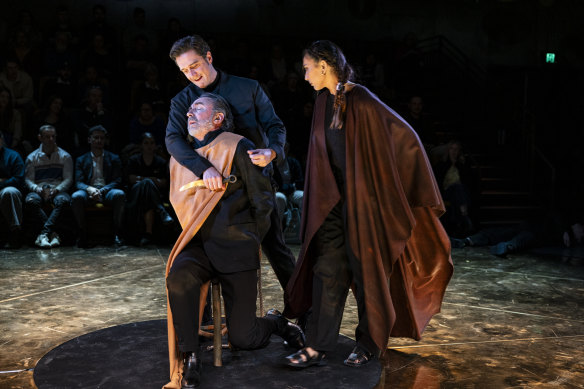
L-R: James Lugton, Michael Whar, Tamara Lee BaileyCredit: Brett Boardman
That’s one essence of the tragedy. “Age is unnecessary,” as Menzies’ Lear quips sardonically. The elderly are expendable.
Another crux is the fact that Lear is king of a deeply misogynistic world. He fears and hates the feminine – within himself, and in others – and he’s passed on the curse to his offspring. Cutting the worst of the mad king’s misogynistic ranting seems like a dramaturgical mistake.
The domestic drama from which political and existential crisis flows is smoother in the subplot with Gloucester (James Lugton) and his sons Edgar (Alex King) and Edmund (Darius Williams), than it is between Lear and his daughters.
Melissa Kahraman’s Cordelia, Lizzie Schebesta as Goneril, and Tamara Lee Bailey’s Regan trace recognisable types but seem a little stranded in pre-conceived ideas to forge credible, individual human characters, and the staging sometimes diffuses, without cause, the intensity of the family conflict.
The uncaring world of the play is evoked through a circular set, above which the heavens themselves have stopped moving. It’s a sense of cosmic tragedy that this production, despite its virtues as a reasonable introduction to King Lear, ultimately fails to earn in performance.
Reviewed by Cameron Woodhead
DANCE
Little Murmur ★★★
Arts Centre Melbourne, until August 4
It was almost 10 years ago when British dancer Aakash Odedra, a protégé of the celebrated Akram Khan, created Murmur 2.0, an expansive solo exploring childhood experiences of dyslexia. The show, which was made with Australian choreographer Lewis Major, was a breakout success for Odedra’s company – touring widely and garnering much praise.
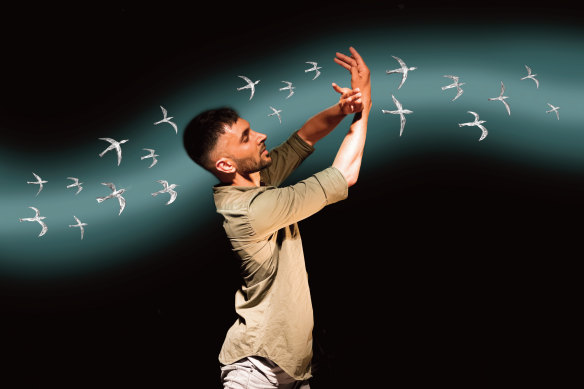
There is much to admire in this pint-sized remake of a hit show.Credit: Angela Grabowska
Murmur 2.0 has now been reimagined as Little Murmur, a shorter and more intimate version aimed at younger audiences. It translates the story of Odedra’s struggle into a series of evocative scenes suggesting feelings of confusion and helplessness, while also showing how dance, too, can be a positive mode of expression.
We are introduced to Kalli – dancer Kallirroi Vratti – who realised at the age of 21 that, all her life, she had misspelled her own name. The struggle for control of her identity is then depicted through a neatly orchestrated combat between Vratti and a digital avatar projected onto a thin curtain.
In this contest, Vratti asserts her strength and agility, particularly in the energetic floorwork, drawing cries of appreciation from the young audience. The written language may be a struggle, but Vratti shows that there are other ways of saying who you are and showing what you can do.
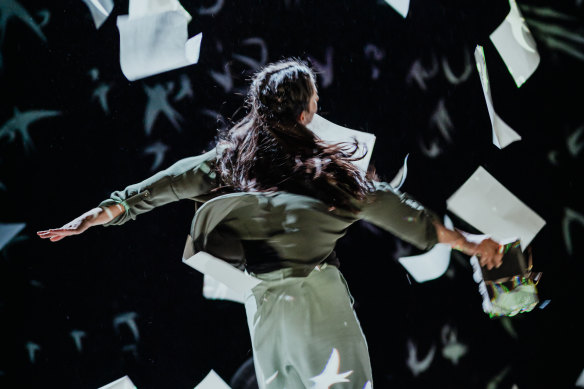
Little Murmur explores the struggle for control of identity.Credit: Angela Grabowska
The text used in this adaptation for families is a little too obscure and fragmentary. It’s possible that by addressing the audience more directly – rather than posing enigmatic questions that have no answer – Odedra could have established a more direct connection with those kids who, like he did, struggle with conventional schooling.
There is, nonetheless, much to admire in this pint-sized remake of a hit show.
The final extended scene is particularly enchanting. Sheets of paper fall from the ceiling and are then swept back into the air by a ring of fans, creating a kinetic image of bafflement in a whirling world of printed words.
Reviewed by Andrew Fuhrmann
JAZZ
Zela Margossian Quintet ★★★★
Bird’s Basement, July 27
Before Zela Margossian moved to Australia in 2008, she was immersed in the world of classical piano. But after years of intense classical studies – first in Lebanon, then in her native Armenia – the pianist was ready to forge a new path.
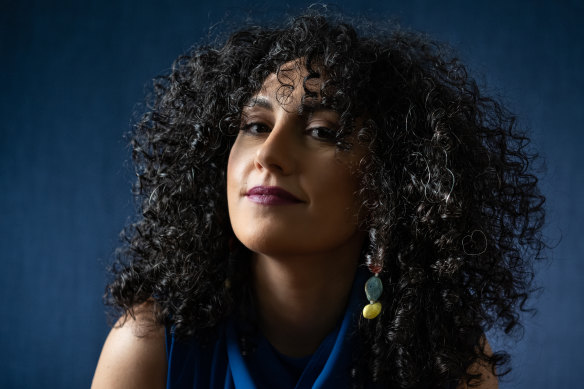
Pianist Zela Margossian has successfully forged a new career in jazz. Credit: Mariana Calzada
She took the plunge and transitioned to a career in jazz (hence the title of her debut album, Transition). Her latest album (The Road) celebrates the journey she’s been on since turning to jazz, while acknowledging that it has no definitive end point.
On Saturday night at Bird’s Basement, the pianist introduced us to the Sydney band that has shared much of this journey with her. The quintet has only performed in Melbourne a handful of times, and it was a full house that greeted them as they invited us into Margossian’s enchanting musical world.
At the heart of that world lie the pianist’s elaborate compositions, which weave together the myriad influences of her upbringing, cultural heritage and lived experiences.
Echoes of Armenian folk flit through her melodies, which can be hauntingly lyrical or urgently propulsive – sometimes within the same tune. Rhythm, too, plays a crucial role. On Saturday night, the band displayed extraordinary cohesion as they skipped nimbly across shifting time signatures, stop-start passages and polyrhythmic interludes.
Yet despite the complexity of Margossian’s writing, the musicians maintained a sense of effortless flow. Their instrumentation allowed for a kaleidoscopic array of colours and textures, with Stuart Vandegraaff switching between alto sax, soprano sax and clarinet, and Adem Yilmaz using a beguiling combination of Middle Eastern and Latin percussion.
At the piano, Margossian guided the band through her intricate arrangements while beaming with delight at the way her colleagues were bringing her musical visions to life. While most of the evening’s repertoire was drawn from Transition and The Road, the pianist also offered glimpses of material from a forthcoming album, reminding us that her creative journey is still unfolding.
Reviewed by Jessica Nicholas
DANCE
Ānanda: Dance of Joy ★★★★
Dancehouse, July 25
Soloist Christopher Gurusamy describes his latest program of contemporary Bharatanatyam as a celebration of the search for freedom through the discipline of classical dance. And it’s an unapologetically joyful experience.
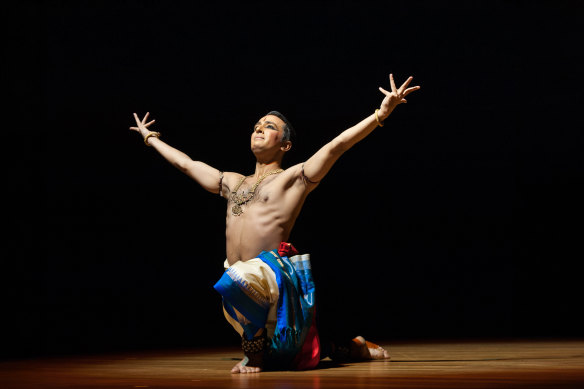
This work is an unapologetically joyful experience.Credit: Natya Ink by Sudha
Gurusamy opens the two-hour recital with a piece on the origins of the universe, inspired by the famous Hymn of Creation of the ancient Rigveda. It is his most innovative and experimental piece – and his most personal.
With its thrilling use of light and darkness, small movements and large, it’s a wonderfully theatrical creation. The total impression is less that of a human being dancing than a cosmic process unfolding, forms becoming, rising from formlessness.
For the second item, Gurusamy chooses a sprightly varnam in Nattakurinji ragam, set to adi talam, composed by Papanasam Sivan. As a dance of joy addressed to Shiva, lord of the dance, this epic story of desire is really the centrepiece of the evening.
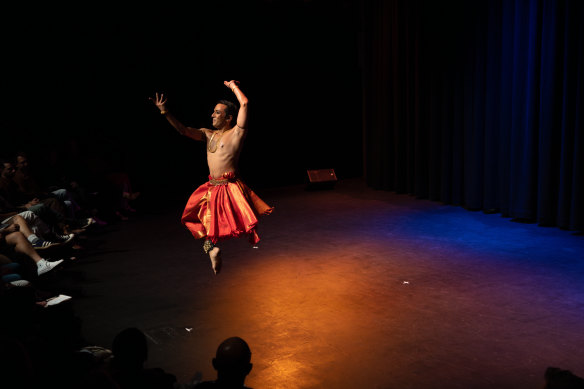
Soloist Christopher Gurusamy describes his latest program of contemporary Bharatanatyam as a celebration of the search for freedom through the discipline of classical dance.Credit: Natya Ink by Sudha
This long but utterly engrossing devotional piece, also choreographed by Gurusamy, with dramaturgy by the celebrated teacher Bragha Bessell, shows off his remarkable agility, with spring-heeled lateral leaps, lightning lunges and ballistic footwork.
After the interval, Gurusamy performs a series of intimate shorter pieces in which he connects abhinaya – the expressive aspect of dance, where the dancer conveys emotions, moods and stories through facial expressions and hand gestures – with his own life experiences.
He offers stories – choreographed by Bessell – of a dancing girl on her way to meet her lover, a woman waiting in her chamber for the return of her lover and a great elephant who is bashful about meeting his old lovers after a long absence.
The exuberant finale, Thillana, commends the pure athletic pleasure of combining melody and rhythm as dance. It highlights the contemporary inflection in Gurusamy’s work, the energy which gives his performances such a feeling of generous cosmopolitanism.
Reviewed by Andrew Fuhrmann
The Booklist is a weekly newsletter for book lovers from books editor Jason Steger. Get it every Friday.